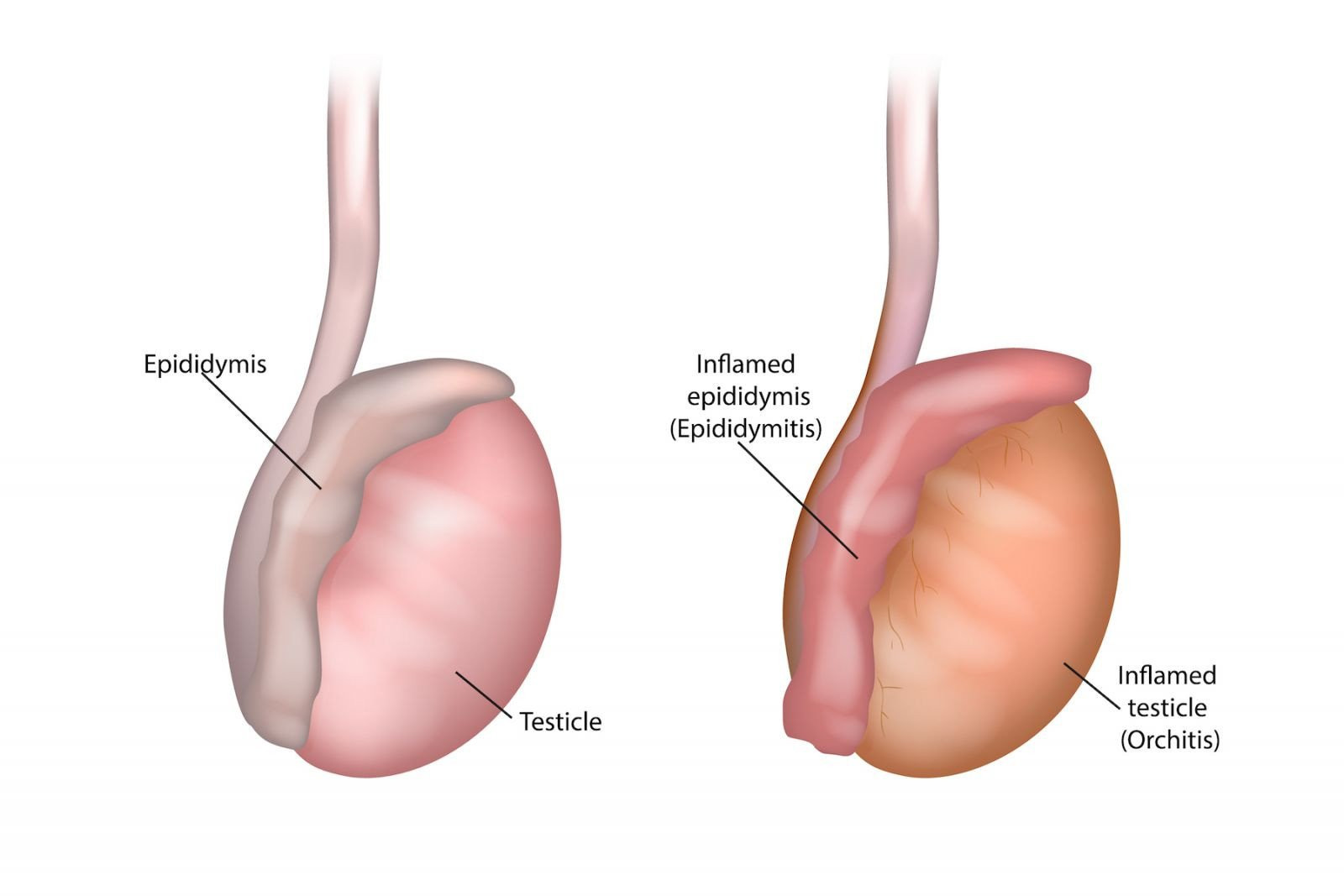Definisi
Epididimitis adalah inflamasi atau peradangan pada epididimis, salah satu bagian dari sistem kemih dan kelamin. Pada pria, epididimis adalah saluran yang menempel pada bagian belakang buah zakar (testis) dan berfungsi untuk membawa sperma yang telah matang. Pembengkakan yang terjadi pada epididimis dapat menyebabkan rasa nyeri pada kedua testis.
Epididimitis dapat terjadi pada pria dari semua kalangan usia, walaupun penyakit ini paling sering ditemukan pada kisaran usia 14-35 tahun. Ada sekitar 600 ribu pria yang menderita penyakit ini setiap tahunnya di Amerika Serikat. Karena saluran epididimis berdekatan dengan testis, terkadang testis juga bisa ikut terinfeksi. Kondisi ini dikenal dengan nama epididimo-orkitis.
Penyebab
Epididimitis paling sering disebabkan oleh infeksi bakteri. Pada pria yang berusia 20-39 tahun, sebagian besar kasus dikaitkan dengan infeksi menular seksual seperti gonore dan klamidia. Sementara itu pada pria dengan usia di atas 39 tahun, sebagian besar bakteri penyebab epididimitis adalah Escherichia coli dan bakteri lain yang sering ditemukan dalam saluran cerna.
Infeksi lain yang juga bisa menyebabkan peradangan pada saluran epididimis adalah mikroba dari infeksi saluran kemih, infeksi prostat, atau tuberkulosis. Bakteri dan mikroba tersebut bisa menyebar dari saluran kemih atau bagian tubuh lain, lalu menginfeksi epididimis dan membuatnya meradang.
Selain infeksi, ada hal-hal lain yang bisa menyebabkan epididimitis, yaitu:
- Cedera pada epididimis atau sela paha
- Olahraga dengan gerakan berulang seperti berlari, melompat, angkat beban
- Infeksi virus
- Efek obat tertentu
- Adanya sumbatan pada lubang keluarnya urine (uretra)
- Pembesaran kelenjar prostat
- Penggunaan selang urine (kateter)
Faktor Risiko
Ada beberapa faktor yang diduga bisa meningkatkan risiko pria mengalami epididimitis, di antaranya:
- Penis tidak disirkumsisi atau disunat
- Melakukan hubungan seksual tanpa kondom
- Memiliki kelainan struktur saluran kemih
- Menderita penyakit tuberkulosis
- Riwayat melakukan prosedur operasi pada prostat, uretra, atau kandung kemih
- Riwayat cedera pada area lipatan paha
- Memakai selang urine
- Memiliki gangguan irama jantung dan menggunakan obat amiodarone
Gejala
Epididimitis dapat dimulai dengan gejala yang ringan, walaupun gejala bisa menjadi semakin berat apabila kondisi ini tidak ditangani dengan baik. Gejala-gejala yang dapat dirasakan dari epididimitis antara lain:
- Nyeri dan pembengkakan pada kantung buah zakar (skrotum)
- Bisa terasa semakin berat seiring waktu
- Nyeri bisa menjalar dari panggul ke skrotum
- Nyeri saat buang air kecil
- Buang air kecil menjadi sering
- Bisa keluar cairan selarin urine atau semen dari penis
- Testis membengkak dan kemerahan
- Demam menggigil dengan suhu yang tidak terlalu tinggi
- Kelenjar getah bening di area lipatan paha bisa membesar
- Nyeri ketika berhubungan seksual
Diagnosis
Dokter biasanya mendiagnosis suatu penyakit melalui wawancara medis, pemeriksaan fisik, hingga pemeriksaan penunjang bila tersedia dan dirasa perlu untuk dilakukan.
Wawancara Medis
Dokter akan bertanya mengenai keluhan pasien yang dirasakan saat ini. Selain itu, dokter juga bisa bertanya mengenai riwayat penyakit yang dimiliki pasien dan bagaimana aktivitasnya sebelum penyakit muncul. Anda juga perlu memberitahu obat-obatan yang Anda konsumsi untuk mengobati keluhan, atau obat yang Anda konsumsi secara rutin.
Pemeriksaan Fisik
Pada pemeriksaan fisik, dokter akan melakukan pemeriksaan sesuai dengan gejala yang dirasakan oleh pasien sehingga dapat ditemukan beberapa tanda klinis yang mengarahkan dokter pada penyakit tertentu. Pada kasus epididimitis, biasanya kantung buah zakar ditemukan membengkak dan terasa nyeri saat ditekan. Kulit skrotum bisa teraba hangat dan terlihat memerah juga.
Dokter juga bisa meraba adanya pembengkakan pada kelenjar getah bening di area lipat paha atau adanya duh tubuh pada penis. Bila ada keluhan buang air kecil, dokter bisa melakukan pemeriksaan pada anus dan rektum, untuk menilai bila kelenjar prostat membesar atau terinfeksi.
Pemeriksaan Penunjang
Pemeriksaan penunjang juga memiliki peran dalam menegakkan atau memastikan diagnosis dari epididimitis.
-
Pemeriksaan darah lengkap bisa membantu mencari tahu apakah ada infeksi dan anemia pada tubuh penderita.
-
Urine lengkap dapat dilakukan untuk melihat bila terdapat infeksi bakteri dan sel darah merah pada urine.
-
Duh yang keluar dari penis juga bisa diambil sampelnya untuk diperiksa di laboratorium, dan dicari tahu bila ada tanda infeksi menular seksual.
-
Pada beberapa kasus epididimitis, pemeriksaan USG dapat digunakan untuk menilai dan mengambil gambaran diagnostik pada area skrotum.
- CT scan juga bisa dilakukan bila dokter mencurigai adanya penyakit lain yang menyertai epididimitis, seperti batu saluran kemih
Tata Laksana
Tata laksana epididimitis melibatkan pengobatan infeksi yang mendasari peradangan serta meringankan gejala yang dirasakan oleh penderita. Dokter bisa memberikan antibiotik untuk mengatasi infeksi bakteri dan obat pereda nyeri untuk mengurangi keluhan nyeri yang dirasakan. Obat antibiotik yang diresepkan dokter harus dikonsumsi sampai habis.
Selain obat di atas, Anda bisa melakukan hal-hal ini di rumah untuk meredakan peradangan, seperti:
- Mengurangi pembengkakan dengan kompres es secara rutin
- Istirahat total dan hindari beraktivitas berat
- Tinggikan skrotum atau kantung buah zakar selama minimal 2 hari bila mungkin
Apabila epididimitis yang terjadi akibat infeksi menular seksual, maka penderita dan pasangan seksual perlu untuk tidak melakukan hubungan seksual terlebih dahulu hingga pengobatan tuntas dan dinyatakan sembuh.
Komplikasi
Umumnya, sebagian besar kasus epididimitis bisa sembuh setelah diberikan antibiotik. Meskipun demikian, infeksi bisa terjadi lagi di masa depan. Komplikasi bisa timbul bila epididimitis tidak ditangani dengan baik, yaitu:
- Epididimitis kronis (jangka panjang)
- Terbentuknya abses atau kantung nanah pada epididimis
- Bila infeksi menyebar ke aliran darah, bisa terjadi sepsis atau gagal organ
- Epididimitis yang terjadi pada kedua epididimis bisa menyebabkan seseorang menjadi steril
Pencegahan
Terkadang sulit untuk mencegah penyakit epididimitis. Meskipun demikian, ada beberapa hal yang dapat dilakukan untuk mengurangi risiko terjadinya infeksi. Hal-hal yang dapat dilakukan di antaranya:
- Menggunakan kondom untuk mencegah agar tidak tertular infeksi menular seksual
- Tidak berhubungan seksual pada banyak orang
- Melakukan sirkumsisi pada pria dewasa
- Mendisinfeksi dan membersihkan alas duduk toilet setelah digunakan secara rutin
- Menerima vaksinasi TB
Kapan Harus ke Dokter?
Jika Anda mengalami perburukan gejala yang sudah ada seperti nyeri atau rasa tidak nyaman yang terus-menerus, tidak ada perbaikan gejala setelah beberapa hari, nyeri berat pada kantung buah zakar atau demam tinggi, sebaiknya Anda memeriksakan lebih lanjut ke dokter. Dokter akan melakukan wawancara medis, pemeriksaan fisik, hingga pemeriksaan penunjang tertentu untuk menetapkan diagnosis pasti dari penyakit yang mendasarinya dan tata laksana yang tepat dan sesuai kebutuhan.
Mau tahu informasi seputar penyakit lainnya? Cek di sini, ya!
- dr Hanifa Rahma
Rupp TJ, Leslie SW. Epididymitis. [Updated 2022 Feb 14]. In: StatPearls [Internet]. Treasure Island (FL): StatPearls Publishing; 2022 Jan-. Available from: https://www.ncbi.nlm.nih.gov/books/NBK430814/
Healthline. Epididymitis. November 2021. https://www.healthline.com/health/epididymitis
Cleveland Clinic. Epididymitis. July 2022. https://my.clevelandclinic.org/health/diseases/17697-epididymitis












